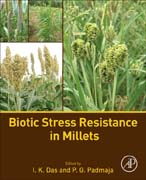
Biotic Stress Resistance in Millets presents an important guide to the disease and pest-related challenges of this vital food crop. Biotic stresses are one of the major constraints for millet production, but newly emerging and forward-thinking problems with disease and insect pests are likely to increase as a result of changing weather, making this an imperative book on best practices. Current strategies are mainly through the development of resistant cultivars, as the use of chemicals is cost-prohibitive to many of those producing millet in developing countries where it is of most value as a food source. This book explores non-chemical focused options for improving plant resistance and protecting crop yield. This single-volume reference will be important for researchers, teachers and students in the disciplines of Agricultural Entomology, Plant protection, Resistance Plant Breeding and Biotechnological pest management. Establishes basic concepts of host resistance providing foundational insight Synthesizes past biotic stress resistance research with the latest findings to orient research for future strategies for plant protectionFocuses exclusively on host plant resistance on all major diseases and pests of millets Presents data and strategies that are globally applicable as millets gain importance as a health food INDICE: Section I: Introduction to millets 1. Introduction2. Origin and distribution3. Area, production and productivity 4. Importance5. Biotic stressesReferences (Sec I)Section II: Disease resistance in millets A. Disease, biology and epidemiology1.1 Introduction1.2 Panicle diseases1.2.1 Grain mold1.2.2 Ergot1.2.3 Smut1.3 Foliar diseases1.3.1 Downy mildew 1.3.2 Blast1.3.3 Anthracnose1.3.4 Rust1.3.5 Leaf blight1.3.6 Leaf spots1.4 Root & stalk diseases1.4.1 Charcoal rot1.4.2 Fusarium root & stalk rot1.5 Bacterial diseases1.6 Viral diseasesB. Host plant resistance 2.1 Nature of resistance2.2 Genetics of host pathogen interactions2.3 Sources of resistance2.4 Genetics of resistance2.5 Mechanisms of resistance2.5.1 Plant defense traits? Morphological? Biochemical2.6 Use of molecular tools2.6.1 Marker assisted selection2.6.2 Transgenic2.7 Future prioritiesReferences (Sec II)Section III: Insect pests' resistance in millets A. Pest, biology and epidemiology1.1 Introduction1.2 Seedling pest1.2.1 Shoot flies1.3 Leaf feeders1.3.1 Grasshoppers1.3.2 Weevils1.3.3 Hairy caterpillars1.4 Borers1.4.1 Spotted stemborer1.4.2 Pink stemborer1.4.3 White borer1.5 Sucking pests1.5.1 Planthoppers1.5.2 Aphids1.6 Panicle pests1.6.1 Midges1.6.2 Earhead bugs1.6.3 Caterpillars1.7 Root pests1.7.1 White grubs1.7.2 TermitesB. Host plant resistance 2. 1 Nature of resistance2.2 Host finding and orientation2.2.1 Chemical cues2.2.2 Visual 2.3 Sources of resistance2.4 Genetics of resistance2.5 Mechanisms of resistance2.5.1 Plant defense traits? Morphological? Biochemical2.6 Use of molecular tools2.6.1 Marker assisted selection2.6.2 Transgenic2.7 Future prioritiesReferences (Sec III)
- ISBN: 978-0-12-804549-7
- Editorial: Academic Press
- Encuadernacion: Rústica
- Páginas: 246
- Fecha Publicación: 19/08/2016
- Nº Volúmenes: 1
- Idioma: Inglés
